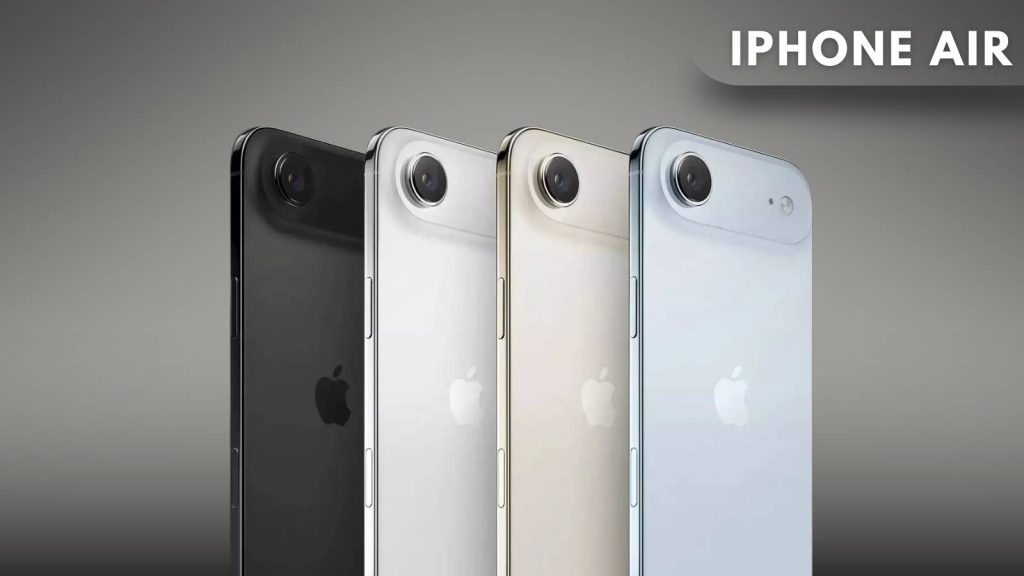The iPhone Air stands out as Apple’s mid-tier smartphone, offering advanced features at a more accessible price. Combining a sleek design, powerful performance, and an upgraded camera system with the latest iOS, it delivers versatile functionality for everyday and professional use.
New iPhone 17 Air Launch: Date, Specification & Everything you like to know
Find detailed breakdown of the iPhone Air’s camera system and full features, comparing pro-level upgrades with standard specs so that you can make an informed purchase decision.
Rear Camera: Standard Specs vs Pro-Level Upgrades
Find iPhone Air rear camera, highlighting its 48MP sensor, Smart HDR 5, advanced stabilization, and zoom capabilities.
48MP Main Camera: The iPhone Air features a 48-megapixel main rear camera with a larger sensor that captures more light, allowing sharper, brighter images even in challenging lighting conditions. Compared to previous standard iPhones, this sensor delivers higher detail and color accuracy.
Focal Lengths & Telephoto Crop: The main lens offers 28mm and 35mm equivalents, and a 2× telephoto crop provides moderate zoom without quality loss. This allows users to capture portraits or distant subjects with impressive clarity. Unlike standard single-lens smartphones, the iPhone Air provides versatile framing options.
Apple iPhone 17 Air May Replace the Plus Model: Here’s Why That’s a Smart Move
Pro-Level Enhancements:
- Photonic Engine improves low-light photography, revealing more detail and reducing noise.
- Advanced Optical Stabilization ensures sharper shots while hand-holding the device or capturing moving subjects.
- Smart HDR 5 captures a wide range of colors and preserves details in highlights and shadows, producing natural-looking photos.
Limitations: The iPhone Air lacks ultra-wide and dedicated telephoto lenses available on Pro models, limiting creative flexibility for wide landscapes or high-zoom scenarios.
Practical Takeaway: For everyday photography, portraits, night photography, and casual videography, the iPhone Air performs exceptionally. Users can enjoy high-quality photos without needing multiple lenses or professional equipment.
Front Camera & Video Features: Pro-Level Capabilities in a Compact Design
iPhone Air delivers advanced front-camera performance with 18MP resolution, Center Stage, and 4K Dolby Vision video recording. Find detailed features and capabilities below.
18MP Front Camera with Center Stage: The front camera automatically tracks subjects to keep them centered during calls and videos, making it ideal for live streaming, selfies, or video conferences. This feature brings professional-like framing to a lightweight device.
Dual-Capture Video: Enables simultaneous recording from the front and rear cameras, which is perfect for creating engaging content such as reaction videos, tutorials, or travel vlogs.
Video Capabilities:
- 4K Dolby Vision recording up to 60 frames per second for cinematic-quality video.
- Action Mode for smooth handheld video captures, reducing shakiness during movement.
- Enhanced Audio Capture through spatial audio for immersive video recording experiences.
Pros: Users gain a compact yet powerful front-camera experience that rivals some Pro devices. It’s perfect for vloggers, content creators, and anyone wanting high-quality video recording without carrying bulky equipment.
Limitations: Ultra-wide front angles and ProRes video editing features are not available, which may affect professional video creators seeking advanced post-production options.
Practical Benefit: The iPhone Air ensures high-quality front-camera performance, making it an excellent choice for daily video calls, vlogging, and social media content creation.
Software & Computational Photography: Hidden Pro-Level Upgrades
Check iPhone Air leverages Photonic Engine, Deep Fusion, and Smart HDR 5 to deliver sharper, more vibrant photos in all lighting conditions.
Photonic Engine: Optimizes each pixel for better low-light performance, improved color accuracy, and sharper details, helping the single-lens camera deliver impressive results comparable to multiple-lens systems.
Deep Fusion: Enhances texture, detail, and sharpness in medium-light conditions, ensuring that images retain their natural quality without oversaturation.
Smart HDR 5: Balances highlights and shadows, delivering professional-grade photos with accurate colors and better depth perception.
Real-World Advantage: Even without ultra-wide or telephoto lenses, the iPhone Air produces stunning portraits, landscapes, and night-time shots that are perfect for social media sharing or personal photography.
User Perspective: Users can capture near-professional images without complex camera setups, making the iPhone Air suitable for casual photographers, content creators, and anyone who enjoys high-quality photography on the go.
Design, Display & Build Quality
iPhone Air features a slim titanium frame, Ceramic Shield protection, and a 6.5-inch Super Retina XDR display with 120Hz ProMotion for stunning visuals. Find detailed design and display features below.
Slim & Premium Build: Measuring just 5.6mm in thickness and featuring a titanium frame, the iPhone Air is both lightweight and sturdy. This design provides a premium feel without adding bulk, making it extremely comfortable for long-term use.
Ceramic Shield Protection: The front and back are fortified to resist scratches and accidental drops, keeping the phone looking new even with daily use.
Display Features:
- 6.5-inch Super Retina XDR display provides bright, vivid colors, excellent contrast, and true-to-life visuals.
- 120Hz ProMotion technology ensures smooth scrolling, responsive touch, and fluid animations for gaming and browsing.
- High peak brightness up to 3000 nits ensures excellent visibility even in direct sunlight.
Practical User Benefit: Combines aesthetic elegance with functional durability and a high-end display, making it perfect for users who prioritize visual experience and portability.
Connectivity, Battery Life & Practical Features
iPhone Air offers eSIM support, WiFi 7, Bluetooth 6, up to 27 hours of video playback, and versatile charging options. Check detailed connectivity, battery, and practical features below.
Connectivity Options:
- eSIM-only support simplifies network management and allows multiple profiles on a single device.
- WiFi 7 and Bluetooth 6 provide faster, more stable connections for streaming, online gaming, and accessory pairing.
Battery Life: Supports up to 27 hours of video playback, making it suitable for heavy users who frequently take photos, record videos, or stream media.
Charging Options: Supports wireless charging and USB-C fast charging, ensuring convenience for different charging preferences.
Additional Features:
- Water and dust resistance for enhanced durability in everyday use.
- Stereo speakers deliver immersive audio for videos, calls, and music.
- Seamless integration with Apple’s ecosystem allows smooth pairing with AirPods, Apple Watch, and Mac devices.
Trade-offs: Slightly smaller battery than Pro models, which may require daily charging for extremely heavy users, and lacks some extreme durability features for harsh conditions.
Practical Takeaway: The iPhone Air delivers a full-featured smartphone experience, ideal for productivity, media, and daily life without compromising key features.
Comparison Table: iPhone Air vs Pro Models
iPhone Air offers most pro-level features in a more compact and affordable package, while Pro models include additional hardware like ultra-wide lenses and LiDAR. Find the detailed feature comparison below.
| Feature | iPhone Air | iPhone Pro |
|---|---|---|
| Rear Camera | 48MP Main | 48MP Main + Ultra-wide + Telephoto |
| Front Camera | 18MP Center Stage | 12MP Center Stage |
| Video | 4K Dolby Vision, Action Mode | 4K Dolby Vision, ProRes, Action Mode |
| Display | 6.5″ Super Retina XDR, 120Hz | 6.7″ Super Retina XDR, 120Hz, LTPO |
| Build | Titanium + Ceramic Shield | Titanium + Ceramic Shield |
| Battery | Up to 27h video playback | Up to 30h video playback |
| Connectivity | eSIM, WiFi7, Bluetooth6 | eSIM, WiFi7, Bluetooth6 |
| Special Features | Dual Capture, Photonic Engine | ProRes, Ultra-Wide video, LiDAR |
iPhone Air includes most pro-level software and camera features, making it a highly capable device for everyday users. While it lacks certain hardware-specific Pro features, it still provides exceptional performance for photography, video, and daily tasks.
For those who want high-quality photography, professional video capabilities, and advanced features without the extra cost, the iPhone Air is undoubtedly one of the most compelling options.
FAQs
Q1: Does the iPhone Air support expandable storage or a microSD card?
No—Apple continues its policy of non‑expandable storage for the iPhone Air. You must choose from built‑in options (256 GB, 512 GB, or 1 TB). This means when you buy it, your storage size should satisfy your long term use (apps, photos, video) because you cannot add a memory card later.
Q2: Which charging standard and port does the iPhone Air use, and how fast is charging?
The iPhone Air uses a USB‑C port and supports fast charging: up to about 50% charge in ~30 minutes with a 20 W (or higher) adapter. It also supports wireless (MagSafe) charging. Note: The exact charge time to 100% will vary with usage, battery health, and ambient temperature.
Q3: How durable is the build? What IP rating, frame material, and screen protection are used?
The iPhone Air has a titanium frame, “Ceramic Shield 2” front and back, and is rated IP68 for water and dust resistance (up to 6 m depth for 30 minutes). This makes it more rugged than many earlier models, but “water‑resistant” is not the same as “water‑proof” for all conditions (e.g., high‑pressure jets or salt‑water).
Q4: What are the major connectivity technologies supported (5G, WiFi, Bluetooth, UWB)?
iPhone Air supports 5G (sub‑6GHz bands), WiFi 7 (802.11be), Bluetooth 6, and Ultra Wideband (UWB) chip (2nd generation). This means the phone is future‑ready for high speed wireless networking, improved device‑to‑device connectivity, and spatial location services (via UWB).
Q5: How long will the software updates last / how “future‑proof” is the iPhone Air?
While Apple doesn’t publish an exact number of years for iOS updates, historically mainstream iPhones receive ~5‑7 years of major OS updates. Given the Air uses top‑tier hardware (A19 Pro chip) and is flagship‑grade in many respects, it is reasonable to expect at least 6‑7 years of software support—making it a solid long‑term choice.
Q6: Will the iPhone Air handle heavy gaming and demanding apps smoothly?
Yes. With the A19 Pro chip and high performance GPU/Neural Engine (6‑core CPU: 2 performance + 4 efficiency cores) the iPhone Air is capable of handling AAA games, graphics‑intensive apps, and multitasking with ease.If you are a gamer or use machine‑learning powered apps, this phone has the hardware to keep up.
Q7: Does the iPhone Air support dual SIM or physical + eSIM?
iPhone Air appears to lean heavily on eSIM‑only in many markets (to save space and support thin design) though region‑specific information may vary. For example, Apple emphasised eSIM in some announcements. If you travel internationally, you may want to verify with your local carrier whether a physical nano‑SIM slot is available or only eSIM.
Q8: What about stereo speakers and audio quality—does the iPhone Air compromise on audio output?
Some reviews and user comments point out that the iPhone Air uses a mono bottom‑firing speaker rather than a full stereo pair, which could impact rich audio for videos/audio consumption. If audio output is a key feature for you (e.g., mobile video editing, listening without headphones), you may want to test it personally or compare with models that guarantee full stereo.
Q9: What are the limitations for photography or camera hardware compared to Pro models that aren’t always obvious?
While the iPhone Air offers a powerful 48MP main camera and excellent software features, it lacks a dedicated ultra‑wide lens and large optical zoom (telephoto) found in Pro models. That means if you frequently shoot landscapes, architecture, large group selfies, or long‑range zoomed scenes, you might feel limited. (Also, review threads mention the missing DisplayPort Alt‑Mode for external devices) It’s therefore very capable but not “no‑compromise” in professional shooting scenarios.
Q10: Are there any known export/import or global compatibility issues (e.g., network bands, charger compatibility, region locking)?
The iPhone Air supports a wide range of cellular bands (including many LTE and 5G frequencies) which helps global roaming. In some countries the eSIM‑only design might limit dual‑SIM physical usage or carrier restrictions. Charging adapters and plugs differ by country, so if importing from abroad you’ll want to ensure correct charger compatibility and warranty status.




